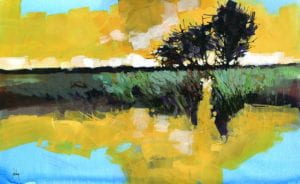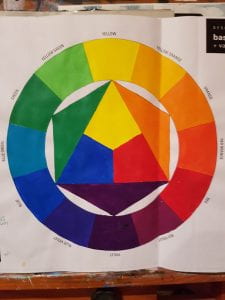Blog Post #2

“It’s art that does not attempt to represent an accurate depiction of a visual reality, but instead uses, shapes colours, forms and gesture marks to achieve that effect.” – Tate Gallery, London
Progress:
In the past two weeks, I have only been able to meet once with my mentor, using the first week to get the necessary supplies to start off my journey. This includes a pack of acrylic paints with only the primary colours and black and white (Having only these can create any colour), Gesso (to prime a canvas), and a large piece of canvas paper for a future project. In this first meeting, I started off with the definition of abstract art. This is how my mentor described it to me:
“Abstract art is not creating something you would see in real life”
“You are getting across the feeling you have towards something and not what it looks like.”
I was also able to discuss with my mentor about the kinds and levels of abstract art and what I am interested in creating. Some people are interested in semi-abstract art where it is a recreation of something you would see in real life but is represented in a simplified way. An example of a level of semi-abstract was turning a landscape into basic shapes and lines. Then there is non-objective art which is a type of abstract art that has nothing at all that is representational about it. This is my mentor’s favourite type of abstract art, and the type I am the most interested in.

This week’s assignment from my mentor is to create a piece that is filled with irregular shapes using only the colours yellow, red, white, and black. Each shape must be a different shade, and this shows my knowledge of mixing and blending colours together. Once complete, I can make it more interesting by using these paint pens called Posca Pens to add drawings or designs over top.
What I am hoping to do next week is continue blending and creating colours but using cold colours instead of warm colours. I have already learned a lot in just one meeting and I cannot wait to expand my knowledge of abstract painting even more.
Grounding The Work:
1. How did your mentor gain their experience/ expertise?
My mentor (My grandma) started painting in high school, but then developed an interest and changed to focus on ceramics while she was in art school. She hadn’t begun to really paint again until 2014 after she took an abstract course. Ever since, she has loved creating art and is continuing to learn and improve her expertise.
2. What were those experiences like for your mentor?
When she started picking up interest in painting again in 2014, she had no idea what to expect for the weeklong abstract course. (Art2Life, Link down below) She found then that she really enjoyed this style of painting and had a real talent for it as well. She has sold most of her paintings and she keeps taking courses to improve her skills. My mentor has found that it continues to stay interesting for her and she loves it.
3. What wisdom have you gained from your mentor so far?
I have learned two main concepts from my mentor so far that have really stuck with me.
a. The different levels of abstract art and how they vary
I learned that there are different levels of abstract art and that there are four main points that contribute to this. Simplification, altering colours, flatness, and texture. Simplification is making an object or landscape simpler in your work. This is usually done by using shapes with little to no fine details. Altering colours is when you take an object and use a completely different colour palette when recreating it. For example, making an apple blue. Flatness is the idea surrounding how 3D, 2D and non-dimensional the object in your painting is. The objective is to make the picture have no dimension; however, this can vary based on the artist’s preference. Finally, texture allows you to make your creation pop out of the canvas. This is different from the flatness of the painting, where it is talking about perspective. All these concepts can vary based on the artist’s style and they contribute to how abstract I want to make my paintings.
b. Seeing the world differently
My mentor talked a lot about learning how to see and seeing the world differently. This is taking what one sees around them and changing the perspective, the focus, and simplifying it, making it flat. One example she discussed was how I could take one of my portraits from last year and simplify it, amplify the shadows, and take away the dimension in a painting.
4. What have you learned so far, in terms of facilitation strategies, that might contribute to your own development as a mentor?
I learned by observing my mentor’s strategies in teaching, and how important it is to simplify your lessons and make sure the mentee understands. My mentor did this by asking clarification questions, talking at a nice pace, and giving many examples to give me a better idea of the concepts being discussed. I found that this worked well for my learning, and I was able to be engaged. I hope that using these strategies I can keep my future mentees engaged as well.
5. Report on any progress and sub-skills learned so far. Share photos, videos and sound recordings where applicable.
I think a sub-skill I learned is around the colour wheel and how to blend primary colours with black and white. This is an important basic skill to learn with painting because it allows one to contrast colours one might not think to contrast and create a whole palette of colours with only a limited amount of paint to start.

Art Course:
Other Links:
Leave a Reply